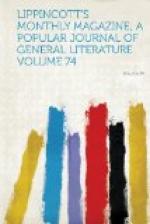It was a cold, feeble hand I respectfully kissed at parting, and I remained under its spell, lingering in the strange world conjured up by Ottilie von Goethe, till we stood before Goethe’s pretty summer-house and the blue violets peeped at us from the turf. The windows stood wide open, the mild breeze swept gently in, and the sun also looked to see if everything was in order in “der alte Herr’s” rooms. Far away between the trees gleamed the white pillars of the house, and the ground at our feet was covered with a blue carpet. It is said that nowhere in North Germany are there so many violets as in the vicinity of Weimar. And why? Because, as the people poetically say, “der alte Herr,” whenever he went to walk, always filled his pockets with violet-seeds, and scattered them everywhere with lavish hands.
ELISE POLKO.
LA BEFANA.
Putting out of the question the Piazza of St. Peter’s with Bernini’s encircling colonnades, which is a special thing and unlike anything else in the world, the Piazza Navona is the handsomest piazza in Rome. It is situated in the thickest and busiest part of the city, far out of the usual haunts of the foreign residents, and nearly in the centre of that portion of the city which is enclosed between the Corso and the great curving sweep of the Tiber. It is handsome, not only from its great space and regular shape—a somewhat elongated double cube—but from its three fountains richly ornamented with statuary of no mean artistic excellence, and from the clean and convenient pavement which, intended for foot-passengers only, occupies all the space save a carriage-way close to the houses encircling it. This large extent of pavement, well provided with benches, and protected from the incursion of carriages, which make almost every other part of Rome more or less unsafe for all save the most wide-awake passengers, renders the Piazza Navona a playground specially adapted for nurses and their charges, who may generally be seen occupying it in considerable numbers. But on the occasion on which I wish to call the reader’s attention to it the scene it presents is a very different and far more locally characteristic one.
We will suppose it to be about midnight on the fifth of January, the day preceding the well-known revel, now come to be mainly a children’s festival, which English people call Twelfth Night and celebrate by the consumption of huge plumcakes and the drawing of lots for the offices of king and queen of the revels. The Italians call it the festival of the “Befana,” the word being a readily-perceived corruption of “Epifania.” Of course the sense and meaning of the original term have been entirely forgotten, and the Befana of the Italian populace is a sort of witch, mainly benevolent indeed, and especially friendly to children, to whom in the course of the night she brings presents, to be found by them in the morning in a stocking or a shoe or any other such fantastic hiding-place. But Italians are all more or less children of a larger growth, and at Rome especially the populace of all ages, ever ready for circenses in any form, make a point of “keeping” the festival of the Befana, who holds her high court on her own night in the Piazza Navona.




